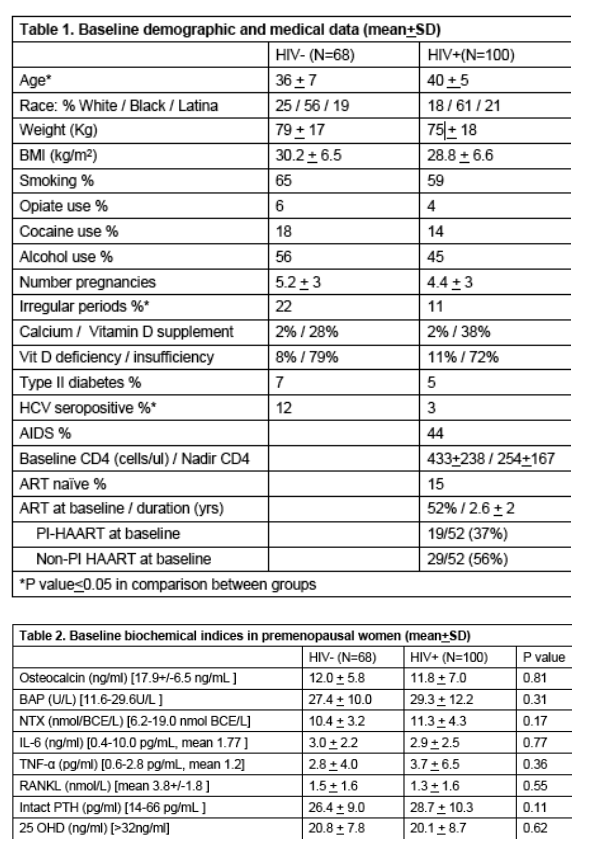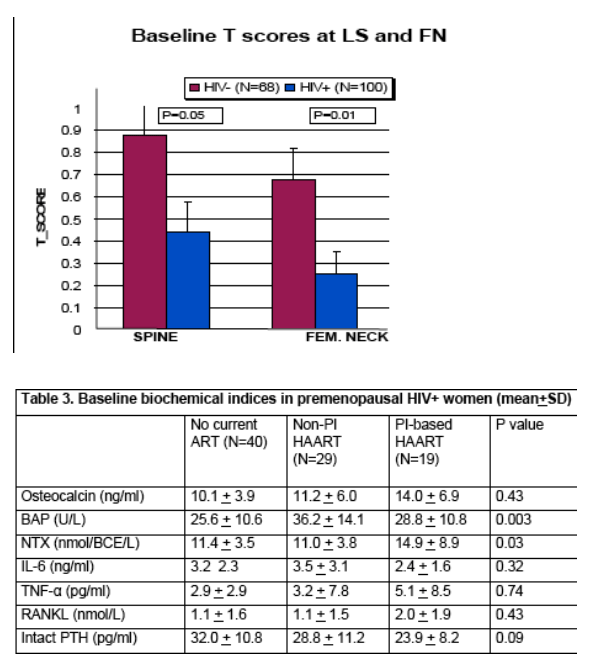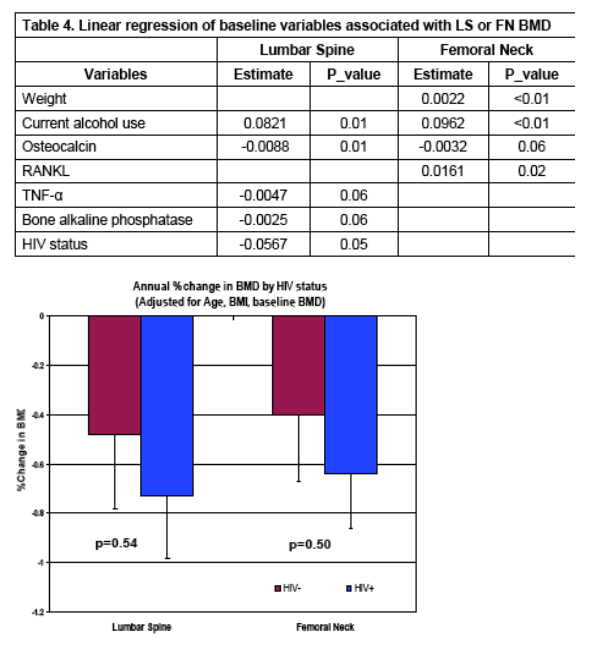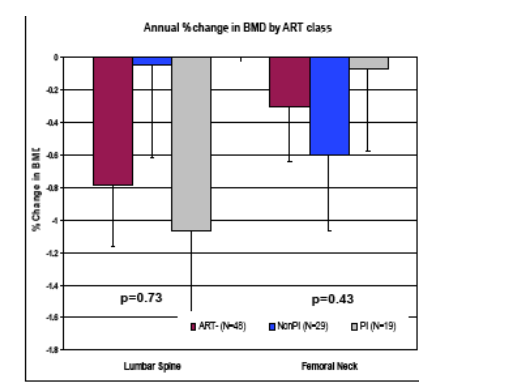 |
 |
 |
| |
Short term bone loss in HIV infected premenopausal women
|
| |
| |
Reported by Jules Levin
CROI 2009 Feb 8-12 Montreal
MT Yin1, S Cremers1, D Lu2, E Shane1,W Gao3, D McMahon1, P Tien4, K Anastos3
1Columbia University College of Physicians & Surgeons, New York, NY; 2Data Solutions LLC, Bronx NY,
3Montefiore Medical Center, Bronx, NY; 4University of California San Francisco, SF, CA
AUTHOR SUMMARY & CONCLUSION
In this cohort of premenopausal, predominantly African American women, baseline BMD was significantly lower in HIV+ subjects, while baseline vitamin D status and bone turnover markers were similar between HIV+ and HIV- women.
Rates of bone loss over 2 years were similar between HIV+ and HIV- women.
Despite higher baseline bone resorption markers and lower formation markers, HIV+ women on PI-based HAART did not have increased bone loss.
We conclude that premenopausal HIV+ women do not lose bone more rapidly
than matched controls.
"Among HIV+, higher baseline BMI was associated with less bone loss (r=-
0.22, p=0.03) and opiate use (p=0.003), diabetes (p=0.002), and vitamin D
deficiency (p=0.004) were associated with more bone loss at the FN"
ABSTRACT
Background Low bone density (BMD) is prevalent among HIV + women. Data on short term bone loss, fracture risk and impact of antiretrovirals is limited.
Methods In 100 HIV+ and 68HIV- premenopausal women enrolled in the
Women's Interagency HIV Study (WIHS), BMD was measured by dual xray
aborptiometry at the femoral neck (FN) and lumbar spine (LS) at baseline and 2
yrs. Baseline serum levels of bone formation (osteocalcin (OC) and bone alkaline
phosphatase (BAP)) and bone resorption (N-telopeptide (NTX)) markers, and proresorptive cytokines (IL-6, TNF-α, and RANKL) were determined.
Results
HIV+ women were older than HIV- (40+/-5 v 36+/-7 yrs, p<0.01 and
fewer had irregular periods (11% v 22%, p=0.05) but were similar with regard to
race, BMI, prevalence of smoking, alcohol use, heroin use, diabetes, calcium and
vitamin D deficiency.
HIV+ women had lower baseline LS BMD than HIV- (1.25+/-0.2 v 1.31+/-0.2 g/cm2, p=0.05) and lower FN BMD (1.05+/-0.1 v 1.10+/-0.2 g/cm2, p=0.03). FN BMD was lowest in HIV+ women on PI based HAART (HIV+PI+) (0.99+/-0.1 g/cm2).
Baseline serum bone turnover marker and cytokine levels were similar between HIV+ and HIV-. Annual % change in BMD was similar in HIV+ and HIV- at FN (-0.64+/-0.3 v -0.40+/-0.3%, p=0.50) and LS (-0.73+/-0.3 v -0.48+/-0.3%, p=0.54), after adjusting for age, BMI, and baseline BMD in mixed model analysis.
Among HIV+, NTX levels were higher among HIV+PI+ in comparison to those not receiving ART (14.9+/-6.9 v11.4+/-3.5 nmol BCE/L, p=0.03) and BAP lower among HIV+PI+ in comparison to HIV+PI- (28.8+/-10.8 v 36.2+/-14.1 U/L, p=0.03); however annual % change in BMD was similar between all treatment groups. Lastly, over a 2 year follow up, occurrence of new selfreported fragility fractures was similar between the two groups (3%).
Conclusions In premenopausal HIV+ women, baseline BMD was lower than
comparable HIV- women but rates of short term bone loss at the LS and FN and
fragility fracture were similar. In HIV+ women on PI based HAART, elevated bone
resorption and depressed bone formation markers did not translate to increased
bone loss.






Among HIV+, higher baseline BMI was associated with less bone loss (r=-
0.22, p=0.03) and opiate use (p=0.003), diabetes (p=0.002), and vitamin D
deficiency (p=0.004) were associated with more bone loss at the FN
Among HIV+, higher baseline BAP (r=-0.30, p=0.01) and osteocalcin levels
(r=-0.20, p=007) were associated with less bone loss at the LS
HIV (AIDS, CD4) and ART specific variables did not reach significance
|
| |
|
 |
 |
|
|